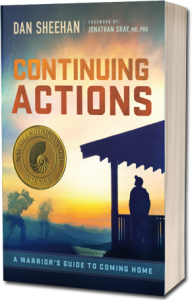Continuing Actions Chapter 9
LOOK AT IT
“By itself, reconstructing the trauma does not address the social or relational dimension of the traumatic experience. It is a necessary part of the recovery process, but it is not sufficient.” —Judith Lewis Herman, Trauma and Recovery, p.183
I HAD A GOOD FRIEND in college who loved to get hammered and expose himself in public. More than once I lost track of him while stumbling home from the bars only to find him standing proudly in the middle of the street, pants around his ankles, shouting “LOOOOOK AT IT!” to anyone within earshot. This is only tangentially connected to the focus of this chapter, and I may be rightly accused of using it as a cheap attention getter, but oh well. It’s relevant because we’re getting to the point in our journey where we need to share the intimate and sometimes painful information we discovered during the process of creating our own true narratives. But this doesn’t mean we should hang out our junk for just anyone to see.
This chapter will explain the benefits of communicating your experiences through whatever medium works for you. I accomplished this through writing, and later, through public speaking, but those are not the only ways to do it. Want to paint yourself green and do interpretive dance in a Speedo®? Go ahead. But chances are you’ll find more low-key ways to express yourself such as painting, photography, music, or drawing. Because the field of art therapy is spread across so many modes of expression, I will not attempt to introduce a comprehensive list of the different types of art here. Instead, I’ll use my own experience with writing to identify the positive impact of sharing difficult information, as well as to introduce considerations for whom to share it with. What type of art should you choose? That’s totally up to you. All your art needs to do is give you a way to express yourself.
But don’t drop trou and “express” yourself with just anybody, not right off the bat, anyway. Your initial rounds of sharing are a continuation of the self-aid plan that started when you began recording your narrative. The information you’ve learned thus far in that process is intimate and deeply personal, but you probably haven’t figured everything out yet. The act of sharing it with the right person will help you access the emotions and reactions that remained hidden during the creation of your narrative. But to share it without regard for the listener’s capacity and willingness to understand risks diluting your focus at a critical point. This loss of focus will increase the odds of stagnation, of failure.
Who makes up this “trustworthy community” capable of receiving your message? They may be people close to you such as family members, good friends, or buddies you served with. Or they may be new friends you’ve met while engaging in healthy self-aid activities. Regardless of how long you’ve known them, the right person to share your narrative with is someone who can listen without judgement and is capable of sharing in your emotions. In many instances, they must be willing to go to hell with you.
The whole point of communicating the difficult emotions you uncovered in your narrative to a person you have a relationship with is that you’re no longer keeping them to yourself. You’re getting them outside of your head and, once released, they cannot be bottled back up. They become a known and accepted component of the relationship between you and the listener.
Drunken exposures to strangers can be denied in the light of day. Because of this escape clause, they lack the therapeutic effects of meaningful, honest sharing. But when you take the risk to truly open up to someone, neither you nor they can make it disappear again. The people you share with will know something real about you, and your relationship with them will deepen as a result. If you spend your life hiding behind a mask of strength, Hollywood heroism, or some shallow concept of warrior-hood, then nobody will ever truly know you. They’ll only know the mask and your relationship with them will remain shallow and distant.
We, as veterans and warriors, have no further use for those masks. They are for the unproven.
SHARING: INITIALLY, IT’S ALL ABOUT SELF-AID
I’d been working on After Action for over a year and a half before I really understood the benefits of sharing my experiences. I’d already recorded the facts of my deployments and overlaid my emotional reactions on them through writing, but some critical connections remained missing. I found myself experiencing intense emotions but unable to tie them to specific events. This gap in my understanding was preventing me from uncovering some crucial information I knew existed but couldn’t put my finger on. And it was really pissing me off.
I went internal and mulled the problem over and over in my head. For the first week or so, my wife gave me space to work it out. But eventually my distracted and distant demeanor prompted her to ask what was going on.
We sat in the quiet living room of the old farmhouse we were renting in Great Falls, Virginia. The kids were asleep upstairs, and the only noises were the wind and the dog snoring by the fireplace. Safe on the couch, I walked my wife through a battle that had occurred on the outskirts of An Numinayah during the 2003 invasion. I didn’t know what I was trying to tell her, or what I was trying to figure out. I only knew that something was there and that it was bothering me. In as much detail as I could remember, I explained where we were, who was in what aircraft—she knew all my squadron mates—and each action I’d taken during the fight. Somehow, while explaining why I chose to fire and how many people I killed with each missile, I got there. I stumbled upon a hidden mental room that contained all the emotions and reactions I’d compartmentalized during the battle.
That particular battle had taken place over seven years before, but the emotions in that room hadn’t aged a day. The reactions that escaped finally brought into focus what had been bothering me for all those years. They provided the connection between the person I knew I’d been before and who I was now.
For some reason, that mental room remained invisible throughout my writing process. But when I started talking through the events of that day, it became clear. I rambled on for a while, running down escaping emotions and examining them without cohesion or concern while my wife sat staring into the fire. These were the little bastards that had been thorns in my side for so long. Now that they were out in the open, there was no way I was going to let them hide again.
When it was over I sat back on the couch, drained. But contented. For the first time in years, I knew why I was upset. I knew what was making me uncomfortable. I kind of looked around the room in amazement for a moment, then looked to my wife for comment. She’d sat, unmoving and silent, for almost an hour while I talked.
Finally she spoke, “That was really hard to hear.”
That wasn’t the response I was expecting.
“Hard? Hard how?” I asked.
“I mean, I really had to focus on what you were saying to keep my mind from wandering.”
This floored me. Inside I was saying, “I’m pouring my fucking heart out and you’re thinking about what? Work? A goddamn grocery list? What could have been more important?”
Luckily, I kept my mouth shut. She continued, “It was hard to listen to because I didn’t want to think about you that way— scared, angry, and hurting. I didn’t want to hear that you’ve felt that way for years and I never knew it. I just didn’t want to imagine you that way.”
As hard as it was for her to hear, it did me a world of good to get it off my chest. And her reaction taught me that whomever I share with will have their own feelings and reactions to what I tell them—and they may not react the way I want, or expect. From that conversation I finally understood what had been bothering me most from my combat tours. Of equal importance was the realization that she, and the rest of my family, were not standing on the sideline. My struggles were as much theirs as mine because they were being affected by me just as I was being affected by my past. On that day I understood that I had never been alone in struggling to carry the burdens of my service.
This understanding went both ways. Now that I’d fully opened up to her, my wife understood that my random bouts of moodiness, angry flashes, and periods of withdrawal were not in response to her, the kids, or anybody else. Now that she knew they were internal fluctuations in my mood and not something that could be “fixed” by anything she could control, she was better able to help me deal with them. That one conversation gave us perspective on my experiences, strengthened our relationship, and allowed me to move forward—and she’d barely said a word. She made no attempt to explain away my emotions or try to minimize them to spare herself from sharing my pain. She just listened, regardless of how much it hurt her to do so.
Who’s your “go-to” person going to be? Think about it carefully.
The person you choose to share with will play an integral role in your ability to fully understand your experiences. This person needs to understand the process you are going through and what they can do to help. One way to do this is to explain it to them. But an easier, and more thorough, approach would be to have them read this book—or at least this chapter. If you both understand the overall concept of your journey, then the chances of success are that much higher. You’ll avoid recreating the wheel and the entire process can move ahead smoothly.
A NOTE TO “LISTENERS”
Asking a person to listen to the full impact of our experiences— not just the vignettes we tell at the bar—is one of the greatest honors we, as veterans, can bestow on someone. If a veteran has expressed interest in sharing with you, then take heart—you are an important person in their life. They see something that makes them believe you can understand what they’ve been through and that you’re important enough for them to give it a shot. They are offering you a means to understand them as they are now—a critical bit of information if your relationship with them is to grow and progress into the future.
One of the primary things the listener needs to do is listen. While this may sound obvious, many of us have real difficulty listening to what someone actually says. Our mind wanders, we project our own emotions and thoughts into what’s being said, and we jump ahead of the speaker by forming our own conclusions. Active listening is difficult. It takes a lot of concentration, and no small amount of self-discipline, to truly hear what someone is saying. This is especially true when the subject matter is deeply emotional—to both the speaker and the listener. It wasn’t the words I said that made it hard for my wife to concentrate on our conversation. It was the pain I was revealing that made her want to seek mental shelter to protect herself.
Listeners will have to steel themselves for the uncomfortable nature of what’s to come. They will also have to fight back the common tendency of trying to “fix” the problem.
Let me be perfectly clear: There is no fix to the pain caused by experiences in our past. Dead friends never come back to life. The families of those we killed will always miss them. Kids will grow up without fathers and mothers, parents will know the pain of outliving their children, and spouses will face the future without their partner and friend. Innocence lost can never be regained, and the very concept of humanity must be reevaluated after seeing what humans can do to each other. The emotions we suffer after the reality of combat are appropriate and healthy. They do not need to be “fixed.” But they do need to be understood.
So, if you are the listener, don’t try to fix anything—just listen. The emotions will probably come out slowly at first, but pretty soon they’ll stream out under pressure. You may need to prompt and prod a little to get it going, but once the speaker accesses trapped information and begins to share it, let him or her go.
You’ll know when the speaker hits this point—their knees may bounce, their eyes will become slightly unfocused in the distance or on the floor, and words will come out in compressed bursts. Raw emotions undiluted by time will pour out, very likely along with tears that may go unnoticed by the speaker. These emotions were white hot when they were compartmentalized years ago. They’ll be white hot the first time they come out, too.
Silence will follow these bursts—but don’t interrupt. Pauses in a normal conversation allow the other party to interject and participate. But this is not a normal conversation. These pauses are not an invitation for you to fill the silence. They are opportunities for the speaker to find the right words to describe something he or she has never said before—or maybe didn’t even realize could be said. This is about them, not you, and they must remain firmly focused on the particulars of their experiences, not anyone else’s. There will be time to share your insights later but for right now, just listen. The accumulated pus of trapped emotions must be allowed to spew out unhindered.
BUDDY AID: THE BUILT-IN COMMUNITY
“What a returning soldier needs most when leaving war is not a mental health professional but a living community to whom his experience matters. There is usually such a community close at hand: his or her surviving comrades.” —Jonathan Shay, Achilles in Vietnam, p.198
The listener who provides your buddy-aid doesn’t have to be a family member. Nor do you have to rely on only one person. At various times throughout my journey, I have relied on my brother, sister, father, and mother to help me understand things I was having trouble with. I’ve also used long runs with a close combat buddy to chew on reactions that I was having a hard time processing. And of course, my wife—a veteran herself—helps immensely as well. My relationships with each of these people are different and so is the support I gain from sharing with them.
But what if your relationships with friends and family don’t support this kind of sharing? Then it’s time to call in some buddy-aid.
Remember the young Marine who almost killed the boy while on patrol in Ramadi? He’s a prime example of someone who didn’t feel comfortable sharing with friends and family—or even his VA counselor. Even though he’d asked for corpsman-aid, it just didn’t work for him. He just couldn’t open up and tell anyone about the boy he’d almost killed. Luckily, buddy-aid was available.
For him, buddy-aid came in the form of Semper Fi Odyssey, a week-long retreat designed to assist wounded veterans transition out of the service. Created and run by retired Major General T.S. Jones, Semper Fi Odyssey helps wounded veterans develop realistic plans for their future after they leave the service. The nonreligious, week-long program of instruction focuses on defining and understanding the four fundamental components of a whole, healthy person: Mental, Emotional, Physical, and Spiritual.
General Jones brings team leaders—most of whom are combat veterans from Iraq, Afghanistan, or Vietnam—and wounded veterans to a secluded camp in the hills of central Pennsylvania. Internet and cell coverage are spotty at best, and the isolation of the camp creates the opportunity for introspective thought and honest self-evaluation. The atmosphere of the camp—unconditional positive regard and a sense of shared profound experiences—is almost as crucial to the participants’ success as the actual instruction.
It was at this camp that the young sergeant finally shared what had been bothering him. I happened to be the one he shared with, but it could have been any of us. It wasn’t the friends he’d buried, nor the Iraqis he’d killed that were haunting him. It was the decision he’d made while staring at the boy with the rifle. His conscious decision to kill the boy was in direct conflict with his self-image as a good, caring person. The fact that the boy lived didn’t matter in the least. He’d made the decision to kill him— and now he knew what he was capable of.
His immediate, violent reaction to his son jumping on his back put him right back behind the .50cal. The years between the events evaporated in a heartbeat, and he saw himself clearly capable of hurting a child—this time his own. The belief that he posed a very real, lethal threat to his own family reinforced his willingness to do anything possible to keep them safe. Including removing himself from their lives. He’d contemplated doing it permanently—the guns were all in his room in the house—but hadn’t. Not yet.
He told me all this through a series of explosive bursts of conversation. I sat quietly during the interludes as his tears dropped unnoticed on the head of his therapy dog. When I sensed he needed a break, or a chance to regroup, I shared some of my experiences. I never offered platitudes or promised that he’d be okay. I didn’t need to. The effect of just telling another person these deeply painful emotions seemed to lift a weight from his chest. The words he spoke carried poisons from deep within and, as they poured out, his personality emerged from hiding. Over the course of the next hour, small inflections of voice, self-deprecating jokes, and how he wiped tears off on his shoulder with a look that said, “well shit, this sucks,” all told me that the real man inside—not the tortured, self-hating soul—was coming back.
He knew that he had a long way to go still. He knew that counseling offered the best chance for him to fully heal and, now that he knew he was neither alone nor weak, he was willing to give the VA another chance—this time without withholding critical information from his counselor.
He was, and is, a proud man to whom the very idea of admitting pain goes against his concept of strength. But his concept of strength matured when he realized his family needed him in their lives. They stood to lose a father and husband if he didn’t step up and face his demons. Barricading himself in the back bedroom suddenly felt like cowardice—and he was no coward.
We don’t keep in touch anymore, although I’d love to hear from him again. Our conversation, sitting on a rock wall at a camp in central Pennsylvania, served its purpose. The atmosphere created by General Jones set the stage for this Marine to achieve in a single, transformative conversation what had taken me several years of writing to do for myself. He realized why he was upset, knew he was not alone, and knew he was not a monster. More importantly, he knew if he dedicated himself to healing, then he had a bright future with the family he loves—not isolated and forever quarantined for their protection.
This is buddy-aid at its finest. If you don’t know where else to start—or find yourself slipping back into stagnation—contact Semper Fi Odyssey. Or any other, similar nonprofit for that matter. They exist because caring, compassionate people, many of whom are veterans themselves, have figured out their own paths home and want to share what they’ve learned along the way.
None of us faced the challenges of combat alone. There’s no reason to face the challenges of coming home alone, either.



